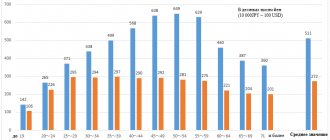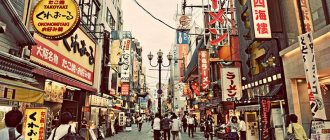Japan Social Security System
Every resident of Japan has the right to receive health insurance, which operates under one of three programs.
All of them are carried out either by public authorities and the government, or by health care organizations themselves. Japan's working population pays insurance premiums regularly, and this generally continues until a Japanese person reaches 70 years of age. Sick or disabled people have the right to pay only a small share of the cost of medical services provided; all other costs are borne by insurance organizations and companies.
In the narrow sense of the word, the social security system includes the following elements:
- Social services for the population;
- Social insurance of the population;
- Public health.
Finished works on a similar topic
- Coursework Social security in Japan 460 rub.
- Abstract Social security in Japan 260 rub.
- Test Social security in Japan 230 rub.
Get completed work or specialist advice on your educational project Find out the cost
But these are not all the areas that fall within the scope of the activities of the Ministry of Health and Social Security. There are also some related industries that provide services and assistance to the working-age population of Japan, who are in difficult economic situations and are unable to independently meet basic needs. These industries also carry out activities to assist the population in finding housing.
Japan is a developed country. In it, as in other developed countries, one of the leading branches of social security is the pension system. It is of great importance, since the country's population is aging rapidly, and therefore needs special measures and approaches to improve its own social living conditions in the current social, economic and political conditions. Today, within the framework of the state political social security system in Japan, there are several developed pension systems, which are based on the key principle of population insurance.
Looking for ideas for study work on this subject? Ask a question to the teacher and get an answer in 15 minutes! Ask a Question
Note 1
Most of these pension systems cover employees at their place of employment. The state pays certain subsidies, mainly in those areas where it is not a direct employer for the Japanese.
Although social security measures in Japan are widespread and vary depending on conditions, there are notable differences between individual parts of the existing pension system, and researchers predict that these will remain in place for a long time. These differences are persistent due to the fact that pension funds and various systems today are quite autonomous and isolated from each other. And a contingent consisting of privileged categories of the population opposes the elimination of such isolation. The ruling classes fear that merging existing pension funds into a single system could lead to a worsening of their own financial situation, completely unaware that this could become an impetus for improving the lives of millions of Japanese throughout the country.
Systemic restructuring is the key to economic development
At the moment, Abe Shinzo's cabinet has not made it clear how the reform of the social security system will proceed. The Abe cabinet tends to focus more on economic development itself than on reforming the system that underpins Japan's welfare society model. In April 2014, the consumption tax rate was increased from 5 to 8 percent, but a second increase to 10 percent, originally scheduled for next year, has been delayed until 2021. The decision was motivated by the fact that the first increase became a brake on the restoration of the economic situation - the goal of Abenomics. As a result, the planned “uniform welfare and taxation reform” became difficult to implement. However, we should not forget that it is the restructuring of the system of social guarantees that is the key to stable and comprehensive economic development.
However, Japan, the first country outside the Western world to become a welfare state, is preparing to challenge the challenge of restructuring the welfare state in response to unprecedented levels of aging society. Can the Japanese model of a “welfare society” be adequately adapted to the realities of 21st century society? This experiment certainly deserves the closest attention of the whole world.
Header photo: ROBEAR robot to help care for the sick and elderly, created at the RIKEN Research Institute of Natural Sciences. As part of a study with an eye to future practical application, the previous model was simplified, significantly reducing the number of parts and assemblies. February 23, 2015, Nagoya (Photo courtesy of Jiji Press)
(Original article in Japanese published April 16, 2015)
Social benefits in Japan
Civic Engagement - Japan Read More Key Findings Trust in government is the foundation of social cohesion and people's well-being.
High voter turnout is an indicator of citizen participation in the political process. Greater public participation in decision-making is essential to holding government accountable and maintaining trust in government institutions. A formal process of public participation in the development of laws and regulations is the only way to measure the extent to which people can be involved in decision-making on key issues that affect their lives.
In Japan, the level of public participation in the development of regulations is 1.4 on a scale of 0 to 4, which is lower than the OECD average of 2.4. Video on the topic: How does the unemployed live in different countries of the world? The social security system in Russia: in search of new solutions to old problems Negative trends in the economy are felt most acutely by the least protected categories of the population.
In the Society section, Work Citizens who lost their jobs between the end of last year - when the employment situation in the country sharply worsened - and this spring are faced with the loss of their source of livelihood: the period when they could receive unemployment benefits , comes to the end. Many of these unemployed people were previously employed as casual workers and are now, in some cases, dependent on meager social security benefits.
One of those waiting in line, a summer resident of Tokyo's Itabashi district with a 5-year-old son, said her unemployment benefits expire in August.
She also said that until April this year she worked at the hotel part-time, but then she and 12 other women lost their jobs due to restructuring.
The woman added that she applied for a job at about 10 companies, but nothing came back from them. Her monthly income, including child care benefits, is about thousand. She explained that if she loses her unemployment benefits in the amount of about thousand.
Cost of childbirth
The cost of childbirth covers various expenses (usually not completely), including hospitalization, examinations and medications. The average amount is said to be around 500,000 to 1,000,000 yen. Opting for a caesarean section or a painless birth with epidural anesthesia increases the price tag by 100,000 - 200,000 yen.
In some regions, costs can be as low as 1,500 yen for prenatal checkups and 250,000 to 500,000 yen for childbirth. Prices and amenities will vary depending on your location . All births vary depending on the hospital or clinic, room, services and meals offered, pain medications, type of birth, etc.
How much should Japanese husbands earn? Survey.
Japan is the safest country for newborns in the first month of their life. The mortality rate for this group of infants is 2.8 per 1000. Singapore holds the record.
| Japan | 2,8 |
| Sweden | 2,7 |
| Bermuda | 2,4 |
| Singapore | 2.3 |
| Angola | 180,2 |
Parents, especially new ones, can breathe a sigh of relief knowing that the birthing process in Japan, followed by the birthing days, will be in good hands.
The whole tragedy of the unemployed Japanese
One of the disasters of modern society is the loss of a job and the lack of opportunity to use one’s labor. Even in the most highly developed countries, such as Japan, Sweden, and the USA, the unemployment rate has never reached zero.
For the Japanese, losing a job is tantamount to a life tragedy. The way labor relations have developed in Japan is that the employer enters into a “lifetime employment” deal with the employee. On the one hand, this contributes to the country's world leadership in unemployment rates. On the other hand, if an employee is fired, it becomes difficult to find a job in Japan again. And for those fired over the age of 40, there is no chance of finding a job again.
Today, those Japanese who have not found work automatically become social outcasts.
Long-term unemployment generates a loss of qualifications and skills; the person loses self-confidence. Hence the spread among the Japanese of such a concept as “hikikomori” - those who withdraw into themselves for a long period and do not leave their home.
Unemployment itself has a destructive effect on a person’s psyche, humiliating his dignity. In fear of being laid off, most Japanese work overtime, violating all the norms of the Labor Code. As a result, the most common concept in Japan is “death from overwork.”
Also, in the “country of workaholics” a record number of suicides was recorded, of which the bulk were among the unemployed and pensioners. According to statistics, 30 thousand Japanese a year voluntarily take their own lives.
Since 2006, Japanese authorities have considered a program to reduce the suicide rate by 2021. The action plan includes measures to loosen the criteria for issuing state benefits to the unemployed. A program for caring for the elderly has also been introduced.
Features of the functioning of insurance companies in Japan
The life insurance market is the highest priority area for development in Japan. This allowed the country to enter the world market and receive approximately 32% of the total number of insurance premiums.
All insurance companies are created only in the format of a joint stock company or partnership, which must have an authorized capital of at least 1 billion yen. The mutual insurance company format is also available, but the capital requirements here are slightly different - 30 million yen. If necessary, the cash deposit can be replaced with securities.
Those companies that are organized in accordance with the JSC format must hold regular meetings of shareholders. Each participant who is on the list of shareholders of the company has voting rights. Such companies may temporarily limit the deduction of dividends if they have not yet covered the costs of registering and running a business. By law, restrictions on dividends exist for the first five years after the opening of a joint stock company.
Insurance legislation
Transformations in the insurance industry began to be carried out along with changes in legislation in 1994. At this time, not only the first steps were taken towards the liberalization of this sector, but also an agreement was established between Japan and the United States on the formation of a system of insurance brokers.
When changing legislation, the following points were taken into account:
- Policyholders should be comfortable working with insurance companies.
- This area must make its contribution to the national economy.
- It is necessary to create conditions for organizing entry into the international market.
In 1999, all requirements regarding government control over the insurance market and its participation in pricing were abolished. Thanks to this, new participants gained access to the market, which attracted third-party funding into the industry.
Types of old-age pensions in Japan
When planning to live in the Land of the Rising Sun at the end of your life, you need to know in advance about a pension in Japan: to whom, at what age, in what amount. The amounts are calculated individually and determined by the number of years worked, money received for it, and contributions paid.
The minimum amount (also known as the first level) is available to every citizen who has paid contributions for 25 years or more. The amounts are calculated based on the amount of contributions and how many years they have been received from the citizen. If the payment period is 40 years or more, the citizen receives a full national pension - 66 thousand yen. This value is about 15% of the average salary. The amount is regularly increased to take into account inflation.
A person who has worked for 40 years can receive up to 180 thousand yen in old age. This does not apply to the self-employed. Typically, women earn half as much because they rarely work after having a child.
Another pension option is an individual, corporate plan. This is the name given to a one-time pre-agreed payment that a citizen receives upon becoming a pensioner. For someone who has worked for 20 years, this is 10-12 payments per year (about 25 million yen). Up to 85% of employers prefer this pension scheme.
There are several pension payment schemes
Deposit Insurance Corporation of Japan
The Deposit Insurance Corporation organizes the deposit preservation process. This is the main national corporation, the system of which is formed by both the government and private banking institutions. It was founded in 1971 and was a government organization whose task was to manage Japan's insurance system.
The purpose of the corporation is to ensure the protection of the interests of investors and the preservation of their invested funds in the event of financial instability. This helps to stabilize the processes occurring in the economic sphere.
Related article: Classification of insurance by industry
Japan takes good care of the insurance issue, providing opportunities for new market players to join the industry. At the same time, legislation protects insured persons by providing them with the opportunity to receive quality care and necessary services in a timely manner.
Features of the Japanese pension system
The complexity of Japan's social and economic system is that the state assumes obligations to provide for the elderly, but the number of those in need is steadily growing. There are more and more pensioners, and the birth rate has been falling for decades. The percentage of people over 65 years of age in the Land of the Rising Sun, compared to the share of working age, is lower than in other countries. In 2010, the share of those who experienced old age was 38%; by 2030 this will be 57%.
The pension system of the Land of the Rising Sun was formed taking into account humanistic ideas about caring for the older generation, international expectations from a power with a high level of development, but also when analyzing the real possibilities of the budget. Although public duty dictates that elderly people be provided with comfortable living conditions, one of the key priorities of financial policy is to reduce spending on social needs, including those related to the age of citizens. Currently, up to 55% of budget expenditures go to ensuring the quality of life of pensioners (including medical care and social care). Conditions for economic survival require a reduction in the budget deficit; the best way is to rationalize expenses. It also affects social payments.
Japan has the longest life expectancy
Is the Japanese pension system reliable?
Now in the Land of the Rising Sun, every citizen can count on government care and guardianship. For an individual Japanese, the system is reliable and gives him guarantees of a comfortable life in his twilight years. From a government point of view, there is a serious problem and reform is needed. If radical changes are delayed, the age imbalance will worsen. Since taxes are mainly paid by able-bodied middle-aged people, the situation will become critical.
Economists suggest that one way out for the country is to raise the age of well-deserved retirement in old age. This way, older citizens will participate longer in the work system, pay taxes, raising the level of income and consumption in general. The second way is to balance the budget. Every older citizen should receive enough money for a decent life, but the pension system, which at the same time acts as an instrument for the redistribution of money in the country, should save the budget, and not just insure society.
Japanese society is aging










